Table of Contents
Table of Contents
In the fast-paced world of network admins, where data flows like the heartbeat of an organization, network availability is the top priority. For admins, it's not just another term, it's a make-or-break factor for the success and smooth operation of everything they manage.
In a world where we're all plugged in and counting on the constant exchange of info, getting network availability right is absolutely critical. This blog is your go-to guide to understanding what network availability really means, why it’s so important, and how to make sure your network stays rock-solid and reliable for your team.
Whether you're a network management pro or just starting out, this post has got you covered with the tips and know-how you need to keep your network running like a well-oiled machine. Let’s dive in!
Network availability, at its core, refers to the ability of a network or system to remain accessible and operational, providing uninterrupted connectivity for its users and applications. It is often expressed as a percentage and represents the portion of time a network is fully operational within a given period, typically measured in a year.
The forumla used to calculate network availability is:
Network Availability = (Total Uptime / (Total Uptime + Total Downtime)) × 100%
The numerator represents the time the network was operational, while the denominator includes both operational time and downtime. The result is expressed as a percentage, with higher values indicating greater network availability.
Network availability is all about keeping your network or system up and running, making sure users and apps stay connected without a hitch. It's more than just a techy term — it’s a measure of how smoothly and consistently data flows across your network. The importance of network availability is huge because it supports the daily operations of businesses, government bodies, schools, and pretty much every part of modern life.
Image if your network suddenly goes down. In an instant, crucial data is out of reach, customers can’t make transactions, and employees can’t work together. The downtime that follows doesn’t just slow things down — it affects productivity, frustrates customers, and could hit the bottom line hard. In short, network availability is the backbone of our digital world, with its impact felt across every aspect of our connected lives.


Network availability is determined by several key factors that work together to ensure a network remains up and running smoothly. Here’s a breakdown of the main ones:
Uptime: Network uptime refers to the period during which a network is fully operational and accessible. This is the opposite of downtime.
Downtime: The period during which a network experiences disruptions, rendering it inaccessible or partially operational. Downtime can result from various factors, such as hardware failures, software issues, or external attacks.
SLA (Service Level Agreement): A contractual agreement that defines the expected level of network availability between service providers and their clients. SLAs typically include specific uptime targets and penalties for failing to meet them.
MTBF (Mean Time Between Failures): This metric quantifies the average time that passes between network failures. A longer MTBF indicates a more reliable network.
MTTR (Mean Time To Repair): This metric measures the average time it takes to restore network functionality after a failure occurs. A shorter MTTR suggests quicker recovery and, therefore, better availability.
High Network Availability refers to a network that is consistently up and running with minimal downtime, often exceeding 99.9% availability. Such networks experience minimal downtime and provide nearly uninterrupted service to users and applications.
This means that the network is reliable, and users or applications can access the services without interruptions. A high availability network typically has multiple backups, failover systems, and proactive monitoring in place to ensure that even if something fails, it quickly switches to a backup without noticeable disruption.
Low Network Availability, on the other hand, means the network is prone to frequent outages and downtime. Networks with availability percentages below 99% are considered to have low availability and are often deemed unreliable.
When something goes wrong (like a server failure or connection loss), it takes longer to recover, leading to poor user experiences and potential disruptions to business operations. In a low availability setup, there may be fewer backup systems or inadequate monitoring, causing the network to be less dependable.

Key Differences Between High vs. Low Network Availability:
- Uptime: High availability = mostly up; low availability = frequent downtime.
- Redundancy: High availability = multiple backup systems; low availability = limited or no backups.
- Recovery Time: High availability = quick recovery; low availability = slow or manual recovery.
In short, high network availability ensures reliability, while low network availability creates disruptions.
As we delve deeper into this blog post, we will explore the methods and network monitoring best practices that network administrators can employ to enhance network availability and reach the coveted realm of high availability.
Are you looking for a robust solution to measure and improve your network's availability? Obkio's Network Performance Monitoring tool is your answer. With a user-friendly interface and powerful features, it empowers network administrators to proactively monitor and optimize network performance. Here's what you can achieve with Obkio:

- Real-time Monitoring: Get a clear, real-time view of your network's performance, allowing you to identify and address issues before they impact your organization.
- Uptime Insights: Measure network availability with precision using Obkio's comprehensive uptime and downtime tracking, helping you meet and exceed service level agreements.
- Alerts and Notifications: Receive instant network monitoring alerts when network issues arise, ensuring quick response and minimal downtime.
- Historical Data: Access historical data and performance trends to make informed decisions about network improvements and investments.
Don't wait for the next network outage to take action. Elevate your network availability with Obkio's Network Performance Monitoring tool today and ensure that your organization enjoys the benefits of a highly available and reliable network.

Network availability and network performance go hand in hand — when one is compromised, the other suffers. Here's how:
1. Reduced Downtime = Better Performance
- High Availability: When your network is up and running consistently, performance remains stable. Users and applications experience smooth, uninterrupted connectivity, with no delays or lag.
- Low Availability: Frequent outages or downtime lead to interruptions in service, causing poor performance. Apps and services may slow down, and users might experience delays, making it hard to maintain productivity.
2. Faster Troubleshooting and Resolutions to Performance Issues
- High Availability: With systems in place for monitoring and redundancy, issues are detected and fixed quickly, often without users noticing a thing. This proactive approach ensures that performance remains stable.
- Low Availability: Without proper monitoring or backup systems, network issues can go undetected for longer, causing performance dips and delays while the problem is fixed.
3. Consistent Speed and Throughput
- High Availability: A reliable network means you’ll have consistent speeds and throughput. No slowdowns or bottlenecks, ensuring that data can flow freely, whether for VoIP calls, video streaming, or file transfers.
- Low Availability: When a network is unreliable, data flow becomes unpredictable. Slowdowns, buffering, or loss of data can occur, affecting the overall performance, especially for time-sensitive applications like video conferencing or VoIP calls.
4. Optimized User Experience
- High Availability: Users can count on smooth, fast, and reliable access to the network, applications, and services. This results in a better overall experience and higher productivity.
- Low Availability: Network instability results in poor user experiences — delays, disconnections, and frustration.
The financial repercussions of network downtime can be staggering for any business. So it's not just about network performance and user experience, it's about revenue and the success of your business.
- Revenue Loss: For businesses, every minute of network downtime translates to potential revenue loss. E-commerce sites, online services, and financial institutions can lose thousands of dollars per minute during outages.
- Customer Churn: Prolonged or recurrent downtime can lead to customer dissatisfaction and churn. The cost of acquiring new customers to replace lost ones can be substantial.
- Penalties and Fines: In regulated industries like healthcare and finance, network downtime can result in compliance violations, leading to hefty fines and legal liabilities.
- Operational Costs: Downtime often requires additional resources and expenses to restore services and rectify the root cause of the issue. This includes overtime pay for IT staff and costs associated with repairs or replacements.
- Reputation Damage: The intangible cost of reputation damage can be the most significant. Customer trust can take a hit, leading to long-term consequences that impact an organization's bottom line.
In summary, network availability is crucial to network performance. High availability leads to stable, fast, and reliable performance, while low availability causes disruptions that negatively impact user experience and productivity.
Discover the competitive edge of proactive network uptime monitoring and get started with Obkio's Network Monitoring tool. Maximize uptime today!
Learn more

Network availability is a critical metric for network administrators, and accurately measuring it is essential to ensure that your network meets the required standards. In this section, we will explore the concepts of uptime and downtime and how to calculate network availability.
We’ll also discuss the role of SLAs (Service Level Agreements) and availability targets in setting benchmarks for network reliability.
Understanding uptime and downtime is at the core of calculating network availability. Here's a breakdown of these key terms:
Uptime: This is the period during which your network is fully operational, providing seamless connectivity to users and applications without interruptions.
Downtime: Downtime refers to the period during which your network experiences disruptions, rendering it partially or entirely inaccessible. Downtime can result from various factors, including hardware failures, software issues, or external attacks.
To calculate network availability, you can use the following formula:
Network Availability = (Total Uptime / (Total Uptime + Total Downtime)) × 100%
This formula provides a percentage that quantifies how available your network is over a specified period. The higher the percentage, the more reliable and available your network is considered to be.
Let's walk through an example of a network availability calculation:
Suppose you're a network administrator responsible for a company's network, and you want to determine the network's availability for the past year. You've gathered the following data:
- Total Uptime (in minutes) for the year: 525,600 minutes (365 days 24 hours 60 minutes)
- Total Downtime (in minutes) for the year: 1440 minutes (24 hours * 60 minutes)
Now, you can use these values to calculate the network availability for the year:
Network Availability = (Total Uptime / (Total Uptime + Total Downtime)) × 100%
Plugging in the numbers:
Network Availability = (525,600 / (525,600 + 1,440)) × 100%
Calculating this:
Network Availability = (525,600 / (527,040)) × 100%
Network Availability = approx 99.73%
So, in this example, the network availability for the year is approximately 99.73%. This means the network was operational and available for about 99.73% of the time, with the remaining 0.27% of the time experiencing downtime.
This percentage is a measure of how reliable and available the network was over the specified period, which is a critical metric for assessing network performance and meeting Service Level Agreements (SLAs) or availability targets.
Service Level Agreements (SLAs) are contractual agreements between service providers and their clients that define the expected level of network availability. SLAs are common in various industries, including telecommunications, cloud services, and data centers.
Key aspects of SLAs include:
- Uptime Targets: SLAs specify the minimum acceptable level of network availability. These targets often exceed 99% to ensure that service interruptions remain minimal.
- Penalties: SLAs typically outline penalties that the service provider must pay to the client if uptime targets are not met. These penalties provide financial incentives for providers to maintain high availability.
- Reporting and Monitoring: SLAs may also include requirements for regular reporting and monitoring of network performance. This ensures transparency and accountability.
Network administrators must align their efforts with SLA commitments to meet the expectations of their organizations and clients. By consistently monitoring and improving network availability, they can ensure that the SLAs are met or even exceeded, resulting in satisfied stakeholders and reduced financial risks.
Setting clear availability targets within your organization is essential. These targets serve as benchmarks for network performance and help you evaluate the effectiveness of your network management strategies. They also provide a basis for future planning and investment in network infrastructure and technologies.
Checking network availability is pretty important for a bunch of reasons, like keeping your business running smoothly and keeping your customers happy. Plus, you've got regulations to follow, and nobody wants to deal with the hassle and cost of network downtime. So, why not make your life easier and use a Network Performance Monitoring (NPM) tool?
These handy tools give you real-time info on what's happening with your network, help you spot problems as they pop up, and even keep tabs on your network's history. They'll shoot you alerts when things go south, and they're great for making sure you're on track with any service level agreements (SLAs) you might have.
But that's not all – NPM tools can help you fine-tune your network, so it performs better, and they save you time by automating much of the monitoring process. In a nutshell, using an NPM tool is a smart move to keep your network in tip-top shape and avoid those nasty surprise outages.
Fortunately, there are solutions available that can help monitor and check network availability monitoring - and troubleshoot network issues affecting it. One such solution is Obkio's Network Performance Monitoring tool.
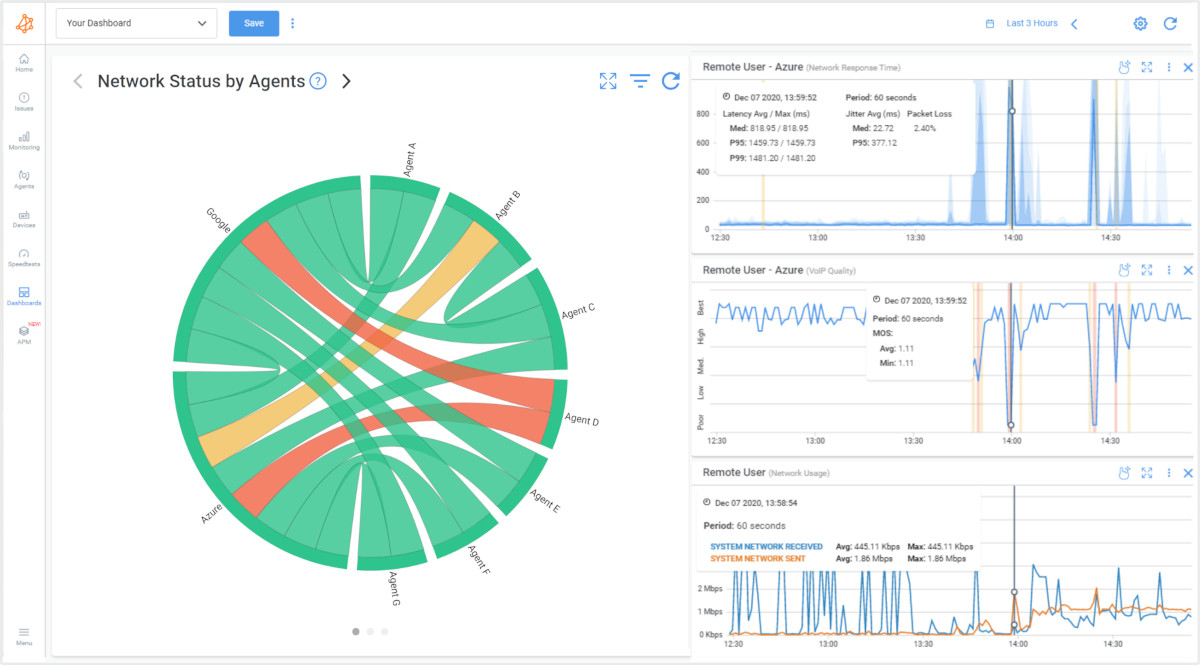
Obkio continuously monitors network performance and network availability throughout your entire network (from WAN to LAN). With a continuous eye on your network performance, Obkio allows you to proactively identify and troubleshoot any issues affecting network availability, or network performance as a whole.
Obkio's solution provides a range of network availability monitoring methods, including:
Agent-Based Monitoring: This method involves the installation of Obkio Monitoring Agents at critical network locations and devices. These agents collect data on various network performance metrics, including devices, Internet connectivity, and more, and then transmit this data to a central monitoring server.
Synthetic Monitoring: Synthetic monitoring simulates user interactions with a network application or service to assess availability and performance. Obkio's solution accomplishes this by generating synthetic UDP traffic, allowing for continuous monitoring of network availability.
SNMP Monitoring: SNMP, or Simple Network Management Protocol, is a widely used protocol for managing and monitoring network devices. Obkio's SNMP monitoring feature leverages SNMP to retrieve essential data about network devices, such as uptime, CPU usage, and memory usage.

Obkio monitors network performance and network availability using continuous synthetic traffic from Network Monitoring Agents deployed in key network locations like offices, data centers and clouds.
For your end-to-end network performance monitoring setup, you’ll need the following Monitoring Agents (which Obkio’s Onboarding Wizard with help you deploy):
- Local Agents: Installed in the targeted office location where you want to measure network availability and monitor network performance. There are several Agent types available (all with the same features), and they can be installed on MacOS, Windows, Linux and more.
- Public Monitoring Agent: These are deployed over the Internet and managed by Obkio. They compare performance up to the Internet and quickly identify if the problem is global or specific to the destination. For example, detect poor network availability between your branch office and Google Cloud.
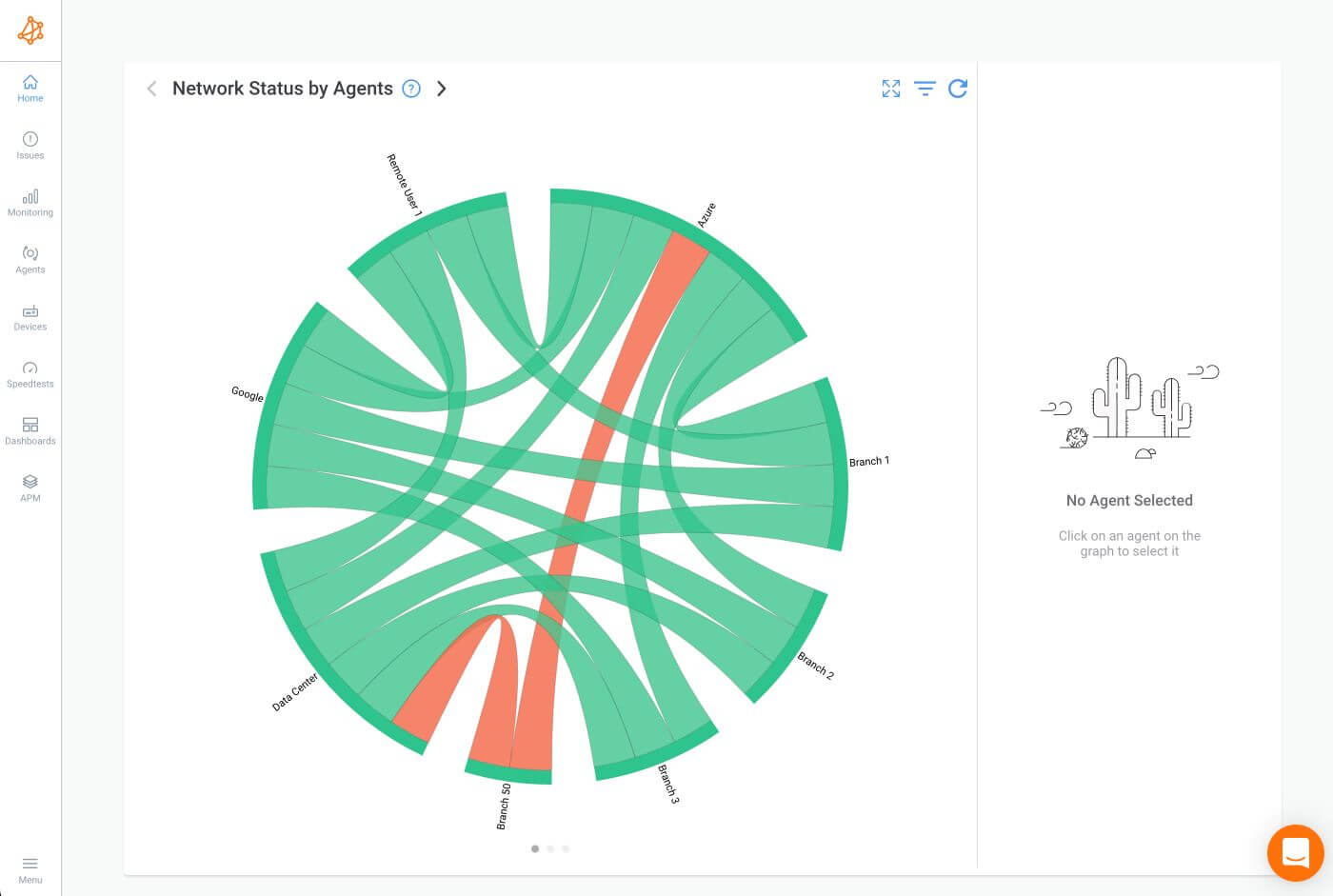
Apart from monitoring network availability rates, Obkio allows you to monitor other critical network metrics that impact network performance and network availability.
Assessing network availability metrics enables you to gauge the reliability and efficiency of computer networks. These metrics serve as valuable tools for IT teams to pinpoint problems, monitor performance, and enhance network infrastructure.
Here are some common network availability metrics:
- Network Uptime: Uptime refers to the percentage of time that the network is available for use. Uptime is typically measured over a given period, such as a month or a year, and can be expressed as a percentage (e.g. 99.9% uptime).
- Network Response Time: Network Response Time refers to the amount of time it takes for a request to be processed and a response to be sent back to the requester. Response time is typically measured in milliseconds and can be used to evaluate the performance of network devices, applications, and services.
- Packet Loss: The Packet Loss metric is the percentage of data packets that are lost or dropped during transmission. Packet loss can indicate network congestion or other issues that may impact network performance.
- Latency: The Latency metric is the time it takes for data to travel from one point to another on the network. Latency is typically measured in milliseconds and can be used to evaluate the performance of network devices, applications, and services.
- Bandwidth Utilization: The metric refers to the amount of network bandwidth being used at a given time. Bandwidth utilization can help IT teams identify potential bottlenecks and optimize network infrastructure to improve performance.
- Error Rate: Network Error Rate is the percentage of data packets that are corrupted or contain errors. Error rate can indicate issues with network hardware or software.
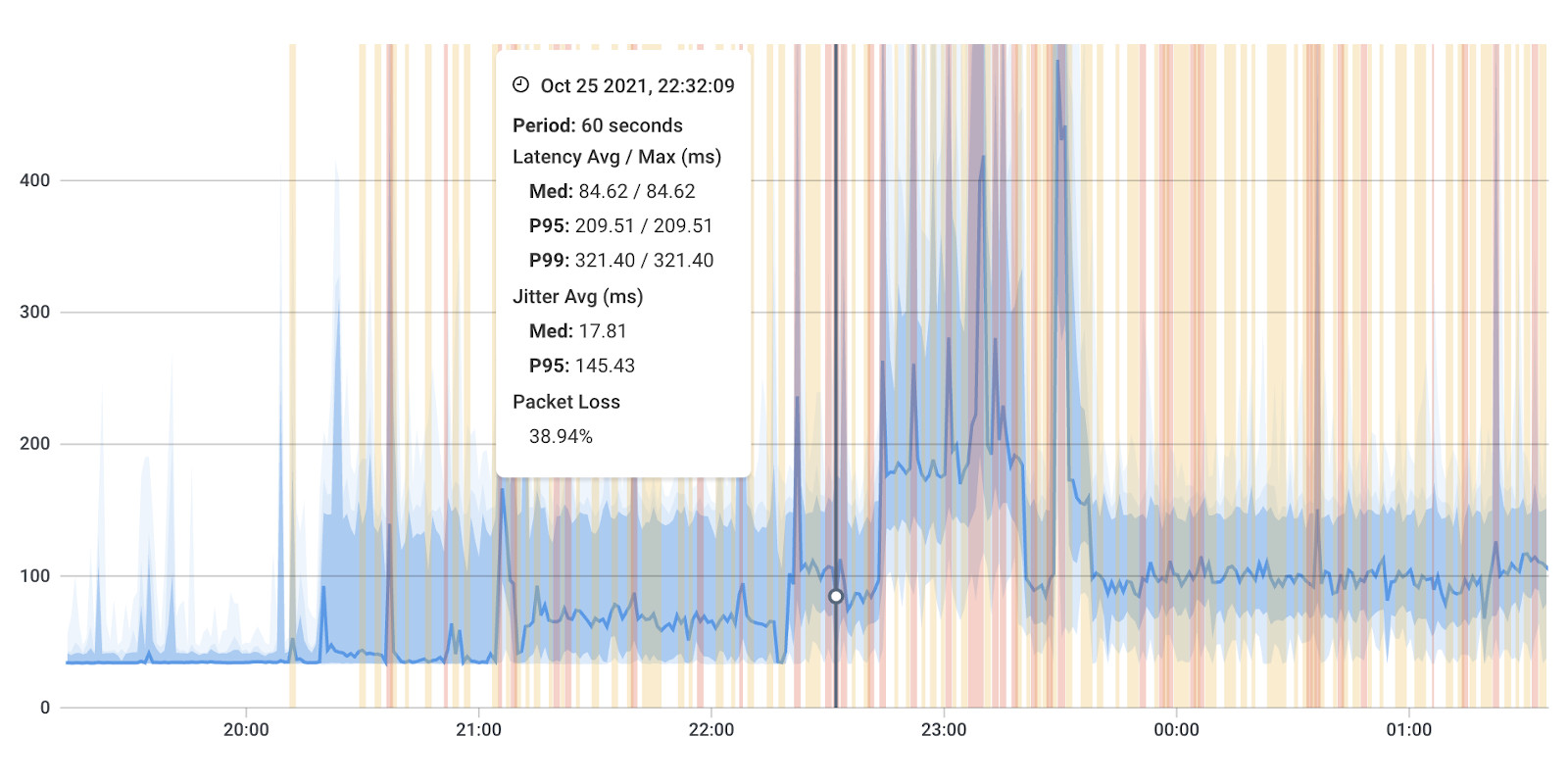
Through the observation of these network availability metrics, IT teams can acquire valuable insights into network performance and availability. This proactive approach enables them to detect potential issues before they lead to downtime or performance hiccups. By optimizing network infrastructure, they can guarantee the consistent availability and expected performance of essential systems and services.
Monitoring network devices is another essential aspect of measuring network availability. Network devices, such as routers, switches, and servers, play a critical role in network infrastructure.
To do so, enable Obkio’s Network Device Monitoring feature, which is a fast and easy solution to get detailed information about the performance of your core network devices using SNMP polling to quickly and proactively pinpoint and troubleshoot network device issues like congestion, and high CPU and interface errors.
Detecting Device Failures: Monitoring devices allows you to promptly identify hardware or software failures. When a device goes offline or experiences issues, it can lead to network downtime. Timely detection enables quick resolution to minimize disruptions.
Assess Device Performance: Monitoring device performance metrics, such as CPU usage, memory usage, and traffic levels, helps in understanding how well devices are functioning. Overloaded or poorly performing devices can impact network availability and should be addressed to maintain reliability.
Track Uptime: Measuring the uptime of network devices is crucial for calculating overall network availability. Devices with high uptime contribute to better network availability, while frequent device outages can negatively impact it.
Monitoring network devices is a fundamental part of measuring and maintaining network availability. It helps ensure that all components of the network are functioning as expected, minimizing the risk of downtime and optimizing the overall reliability of the network.
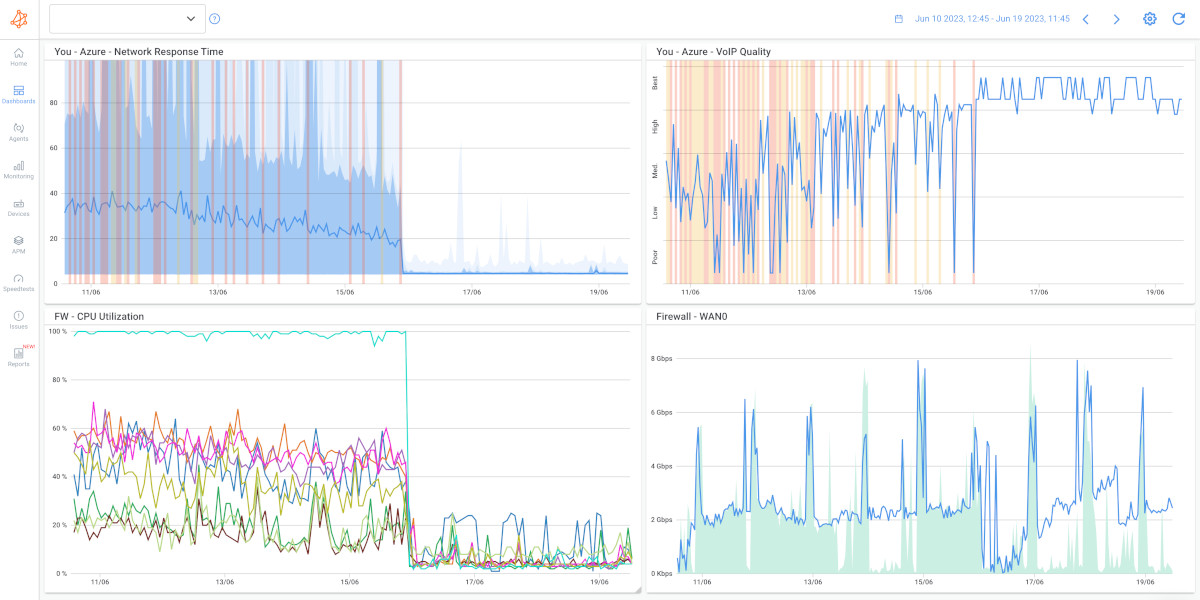
To effectively monitor network availability, it's essential to monitor a range of network devices. The specific devices to monitor may vary based on the size and complexity of your network, but the following are some common network devices that you should consider monitoring:
- Routers: Routers are key devices that direct traffic between different networks. Monitoring routers helps ensure that traffic is properly routed, and it provides insights into their performance and connectivity.
- Switches: Switches are responsible for local network traffic, and monitoring them can help detect issues with local network connections and optimize switch performance.
- Firewalls: Firewalls are crucial for network security. Monitoring firewalls ensures that they are operational and that security policies are enforced correctly.
- Load Balancers: Load balancers distribute network traffic across multiple servers to improve performance and availability. Monitoring load balancers helps maintain even traffic distribution and identifies potential bottlenecks.
- Servers: Application servers, file servers, and web servers are central to network services. Monitoring server performance, resource utilization, and availability is vital for network reliability.
- Wireless Access Points (APs): For wireless networks, APs are critical. Monitoring them ensures that wireless connectivity remains stable, and it can help identify interference or connectivity issues.
- Modems and Gateways: For internet connectivity, monitoring modems and gateways is important to ensure continuous internet access and detect issues with the connection.
- VoIP Devices: If your network supports VoIP (Voice over Internet Protocol), monitoring VoIP devices helps maintain voice quality and communication availability.
- Network Attached Storage (NAS): NAS devices store important data. Monitoring them ensures data availability and alerts you to potential storage issues.
- UPS (Uninterruptible Power Supply) Units: UPS units provide backup power during electrical outages. Monitoring them ensures they are operational and can support devices during power interruptions.
- Printers and Scanners: While not typically considered critical, monitoring these devices can help ensure their availability for users who rely on them.
The specific devices to monitor will depend on your network's architecture, services, and critical components. A comprehensive approach to network availability monitoring typically includes a combination of these devices to ensure a robust and reliable network infrastructure.
After collecting data using Obkio's application, the next step involves evaluating network availability rates through Network Performance Reports. These reports compile information on various network metrics, including latency, packet loss, and throughput, providing a comprehensive overview of network performance over a specific timeframe.
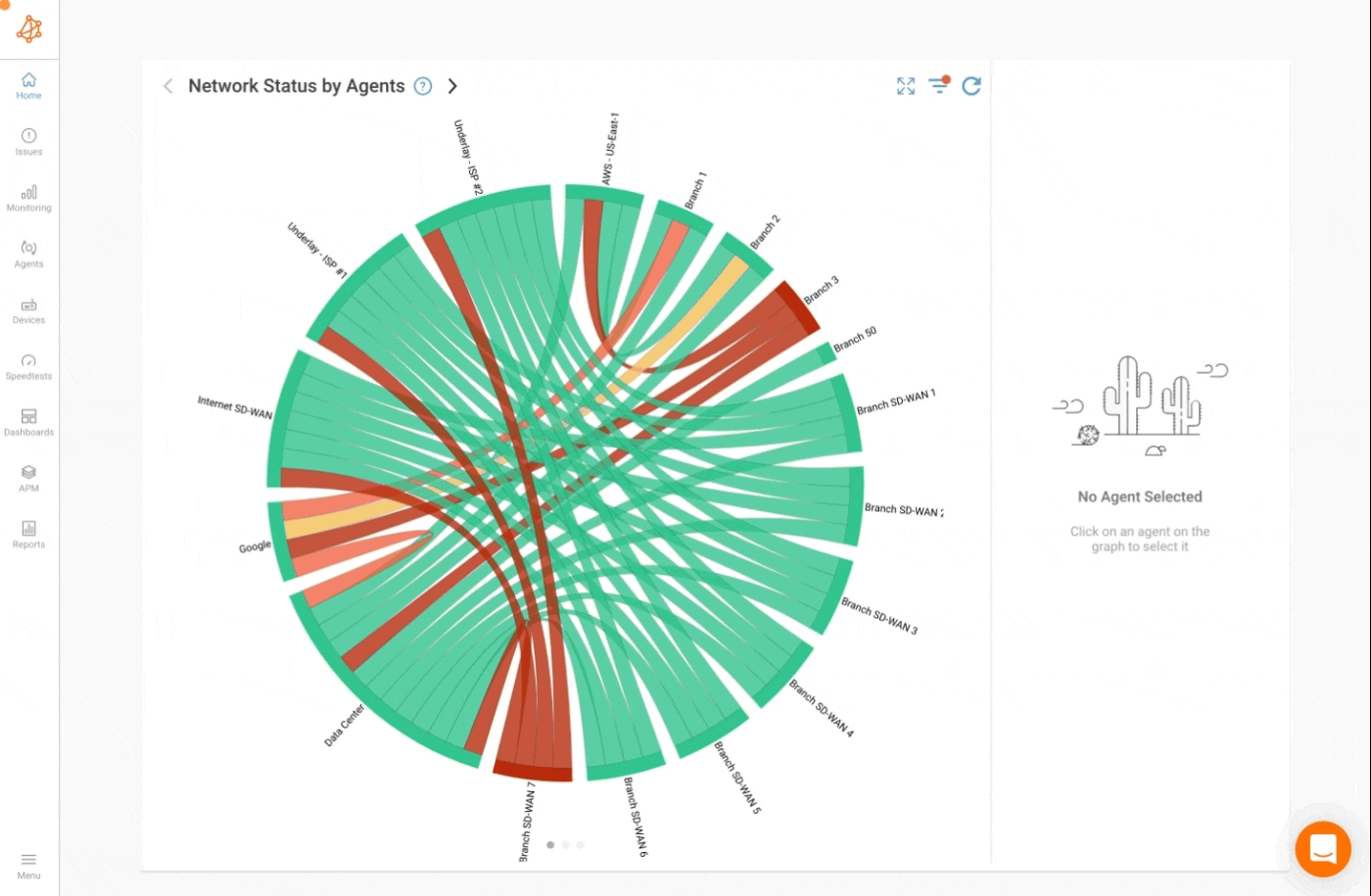
In addition to general network performance, Obkio's platform allows you to specifically assess network availability rates using its reports. Network availability quantifies the percentage of time when the network remains accessible to users. Continuously monitoring this metric offers insights into the network's reliability and consistency.
Moreover, you have the option to analyze and schedule reports that highlight Issue Severities, particularly those categorized as "Critical." When the network availability is low, and the monitoring session experiences interruptions, the severity level is elevated to "Critical."
Obkio's reporting features also permit you to automate report scheduling and apply filters based on severity levels. For instance, you can configure a report to exclusively display critical issues, which are problems capable of causing significant disruptions to network availability. This is especially crucial when network availability is compromised, signifying a critical issue that demands prompt attention.
With this continuous network monitoring setup, you can now continuously measure network availability rates, and proactively identify and troubleshoot network problems affecting network availability!
High network availability is generally defined as having network services and resources accessible for a significant portion of the time, typically exceeding 99%. The specific threshold for "high" network availability can vary depending on the industry, service type, and SLA commitments.
Some common benchmarks for network availability include:
- Five 9s Availability (99.999%): Often considered the gold standard, this level of availability allows for only 5.26 minutes of downtime per year, making it suitable for mission-critical services.
- Four 9s Availability (99.99%): This level permits up to 52.56 minutes of annual downtime and is appropriate for services that require high reliability but can tolerate brief interruptions.
- Three 9s Availability (99.9%): With up to 8.76 hours of downtime annually, this level is suitable for services where occasional interruptions are acceptable but should be minimized.
- Two 9s Availability (99%): Allowing for up to 87.6 hours of downtime each year, this level is appropriate for services that can tolerate extended periods of inaccessibility.
- Low Availability (Less than 99%): Networks with availability lower than 99% may be considered low and are not suitable for critical services. These networks may experience frequent and extended downtime.
Several factors can affect high network availability, potentially leading to disruptions, downtime and network disconnections. Network administrators must be vigilant in identifying and addressing these factors to maintain a reliable and accessible network.
Here are some common factors that can impact high network availability:
- Hardware Failures: The failure of network hardware components, such as routers, switches, and servers, can lead to network downtime. Redundancy and failover solutions are essential to mitigate the impact of hardware failures.
- Software Issues: Software problems, including operating system crashes, software bugs, and misconfigurations, can disrupt network availability. Proper software maintenance, testing, and patch management are crucial to prevent these issues.
- Human Error: Mistakes made by network administrators or users, such as misconfigurations, accidental data deletion, or unauthorized access, can lead to network disruptions. Adequate training, access controls, and best practices can help mitigate human error.
- Security Threats: Malware, viruses, DDoS attacks, and security breaches can compromise network availability. Robust cybersecurity measures, including firewalls, intrusion detection systems, and regular security audits, are essential to protect against security threats.
- Environmental Factors: Environmental conditions, such as power outages, extreme temperatures, and natural disasters, can affect network availability. Uninterruptible power supplies (UPS), backup generators, and disaster recovery plans can help mitigate these factors.
- Network Congestion: Network congestion, often due to increased traffic or inadequate network capacity, can impact network performance and availability. Load balancing and traffic management techniques can help alleviate congestion.
- Third-Party Services: Dependencies on third-party services, such as cloud providers or external service providers, can introduce risks to network availability. SLAs and performance monitoring of third-party services are crucial to ensure reliability.
- Internet Service Provider (ISP) Issues: Connectivity problems or outages with ISPs can disrupt network availability. Using redundant ISPs and diverse network paths can help maintain connectivity.
- Software Updates and Patches: Applying software updates and patches without proper testing can introduce new issues and affect network availability. Testing and monitoring are essential to minimize the impact of updates.
- Network Scaling: Rapid network growth without adequate scaling and capacity planning can lead to congestion and downtime. Scalability planning is crucial to accommodate increased network demand.
- Network Architecture and Design: Poor network design and architecture choices can lead to inefficiencies and vulnerabilities that impact network availability. Regular network assessments and design improvements can address these issues.
- Operational and Maintenance Practices: Inadequate operational and maintenance practices, such as neglecting routine maintenance, backup management, or monitoring, can lead to avoidable disruptions.
To maintain high network availability, network administrators must implement a combination of strategies, including redundancy, proactive monitoring, security measures, and disaster recovery plans. Regular assessments and continuous improvement are essential to address potential factors that could impact network availability.


The relationship between network availability and network downtime is essentially an inverse one. Understanding this relationship is crucial for network administrators and organizations as they aim to maintain reliable network services.
Network availability refers to the percentage of time a network is fully operational and accessible to users.
- It quantifies the reliability and consistency of network services, indicating how often users can access data, applications, and resources without interruptions.
- High network availability means that the network experiences minimal downtime, providing near-continuous service to users and applications.
- Network availability is typically expressed as a percentage, with higher values indicating greater availability.
Network downtime, on the other hand, represents the periods when the network experiences disruptions, rendering it partially or entirely inaccessible.
- Downtime can result from various factors, including hardware failures, software issues, human errors, and security threats.
- During downtime, users may be unable to access critical services, leading to productivity losses, customer dissatisfaction, and potential financial implications.
- Downtime is typically expressed as the percentage of time the network is not available, with lower values indicating more significant downtime.
The relationship can be summarized as follows:
- Inverse Relationship: Network availability and network downtime have an inverse relationship. When one is high (e.g., network availability is high), the other is low (e.g., network downtime is low).
- High Availability, Low Downtime: High network availability means that the network experiences minimal downtime. This results in a network that is reliable, accessible, and responsive to user and application needs.
- Monitoring and Mitigation: Network administrators monitor network availability to ensure it remains high and take proactive measures to minimize downtime. This includes addressing issues that can lead to downtime, such as hardware failures, software glitches, and security threats.
In essence, the goal of network administrators is to maximize network availability while minimizing network downtime. Achieving a high level of network availability is a key objective because it directly correlates with the reliability and performance of network services, which is essential for business operations and customer satisfaction.
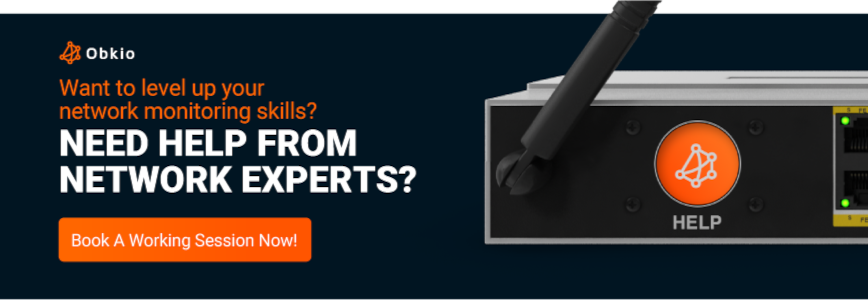
Network downtime can be disruptive and costly for organizations. Understanding the common causes of network downtime is vital for network administrators to proactively address and mitigate these issues. Here are some of the primary reasons networks experience downtime:
Hardware components are the building blocks of a network, and when they fail, it can lead to network outages. Common hardware failures include:
- Router or Switch Failures: These critical network devices can malfunction due to hardware defects, overheating, or power issues.
- Server Failures: Server hardware failures, such as hard drive crashes or memory issues, can disrupt services and data access.
- Power Outages: Electrical issues, including power surges and outages, can affect network equipment and lead to downtime.
- Cabling Problems: Damaged or improperly connected network cables can result in connectivity issues and network disruptions.
- Hardware Aging: As network hardware ages, it becomes more susceptible to failures. Regular hardware maintenance and replacement are essential to prevent unexpected downtime.
Software problems can be equally disruptive to network availability. Common software-related causes of downtime include:
- Operating System Crashes: When the operating system of a critical network device crashes, it can render the device inoperable and lead to network disruptions.
- Software Bugs and Glitches: Software bugs and glitches can impact network services, applications, and devices, causing intermittent or prolonged downtime.
- Misconfigurations: Incorrect configurations of network devices or software can result in misrouted traffic, security vulnerabilities, and downtime.
- Software Updates and Patches: Applying software updates or patches without proper testing can introduce new issues, potentially leading to downtime.
Mistakes made by network administrators, users, or third-party vendors can inadvertently cause network downtime. Common sources of human error include:
- Configuration Errors: Misconfigured network devices, such as routers or firewalls, can disrupt network services and lead to connectivity issues.
- Accidental Data Deletion: Users or administrators may inadvertently delete critical data or make changes that affect network functionality.
- Inadequate Training: A lack of proper training for network administrators can result in errors during routine maintenance or troubleshooting.
- Unauthorized Access: Security breaches caused by improper access or compromised credentials can lead to network downtime and data breaches.
Network security is a significant concern, and security threats can result in network downtime and data breaches. Common security-related causes of downtime include:
- Malware and Viruses: Infections by malicious software can disrupt network operations, steal data, and lead to downtime.
- Distributed Denial of Service (DDoS) Attacks: DDoS attacks flood the network with traffic, overwhelming its capacity and causing downtime.
- Data Breaches: Unauthorized access to sensitive data can lead to network downtime, legal consequences, and reputational damage.
- Ransomware: Ransomware attacks can encrypt network data, rendering it inaccessible until a ransom is paid, resulting in downtime.
By recognizing these common causes of network downtime, network administrators can take proactive measures to prevent and mitigate these issues, ensuring higher network availability and reliability.
Network administrators employ various strategies to enhance network availability, ensuring that networks remain reliable, resilient, and accessible to users and applications. Here are three key strategies for improving network availability:
Redundancy and failover solutions are essential for minimizing network downtime caused by hardware failures, software issues, or other unforeseen disruptions. These strategies involve duplicating critical network components and creating backup systems.
- Redundant Hardware: Deploying duplicate hardware components, such as routers, switches, and servers, to ensure that if one fails, the redundant system takes over seamlessly.
- Data Replication: Duplicating data across multiple servers or data centers to ensure data availability even in the event of a hardware failure.
- Load Balancers: Using load balancers to distribute network traffic across multiple servers, which not only improves performance but also ensures service continuity if one server becomes unavailable.
- Failover Mechanisms: Implementing network failover mechanisms that automatically switch to backup systems when the primary systems experience issues.
Redundancy and failover solutions are critical for minimizing disruptions, maintaining network availability, and providing continuous service to users and applications.
Learn to use network optimization and monitoring to optimize network performance, improve your end-user experience, and compare performance from the past.
Learn more

Load balancing is a technique used to distribute network traffic evenly across multiple servers or resources. Load balancing not only enhances network performance but also plays a significant role in maintaining network availability.
- Server Load Balancers: Deploying server load balancers to evenly distribute incoming network requests, preventing any single server from becoming overwhelmed and ensuring optimal response times.
- Global Server Load Balancing: Distributing traffic across geographically dispersed data centers to improve availability and provide continuous service in the event of data center failures.
- Health Checks: Continuously monitoring the health of servers and automatically routing traffic away from unhealthy servers to maintain availability.
Load balancing techniques are effective for managing network resources efficiently and preventing overloads that could lead to downtime.
Proactive network monitoring is a fundamental strategy for identifying and addressing issues before they impact network availability. This strategy involves continuous monitoring of network performance and early detection of potential problems using continuous Network Monitoring tools, like Obkio.
- Real-Time Monitoring: Using network monitoring tools to observe the network in real-time, enabling quick response to issues as they arise.
- Alerts and Notifications: Configuring monitoring tools to send alerts and notifications when predefined thresholds or anomalies are detected, allowing for immediate action.
- Historical Data Analysis: Analyzing historical network performance data to identify trends and patterns that may lead to future issues.
- Performance Baselines: Establishing performance baselines to gauge network health and deviations from normal behaviour.
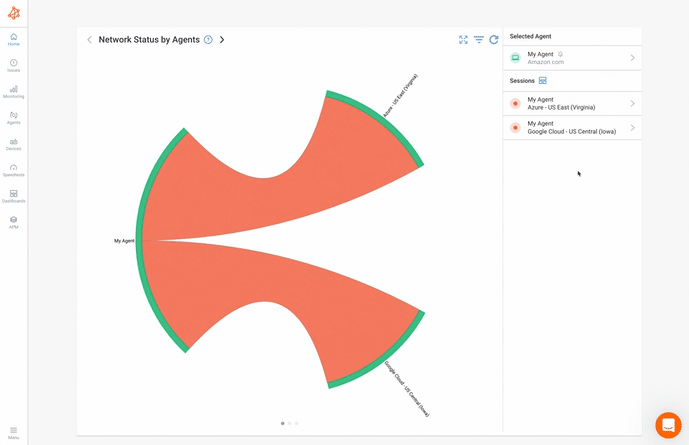
Proactive network monitoring helps network administrators identify and address potential problems, reduce downtime, and maintain network availability.
Incorporating these strategies into network management practices can significantly improve network availability, ensuring that networks remain dependable and accessible to meet business and user demands.
High network availability plays a crucial role in meeting and exceeding Service Level Agreement (SLA) commitments. SLAs are contractual agreements between service providers and their customers that specify the expected level of service quality, including network availability.
Meeting SLA Targets: High network availability ensures that the network is consistently accessible and reliable. This reliability is essential for meeting the uptime targets defined in SLAs.
Customer Satisfaction: When network availability is high, customers experience fewer service disruptions, leading to increased satisfaction and confidence in the service provider's ability to deliver on SLAs.
Reducing Penalties: Many SLAs include penalties for service providers if they fail to meet specified availability targets. High network availability minimizes the risk of incurring penalties and associated costs.
Maintaining Reputation: A reputation for high network availability enhances the service provider's standing in the industry. Customers are more likely to choose and remain loyal to providers with a history of reliable services.
High network availability offers several benefits for both service providers and customers within the context of SLAs:
- Meeting Service Commitments: High network availability enables service providers to consistently meet the uptime targets specified in SLAs, resulting in compliance with contractual obligations.
- Customer Retention: Satisfied customers are more likely to renew contracts and remain loyal to service providers with a proven track record of high network availability. This contributes to customer retention and revenue stability.
- Reduced Penalties: High network availability minimizes the risk of incurring penalties associated with SLAs. This results in cost savings and preserves the provider's profitability.
- Competitive Advantage: Service providers with a reputation for high network availability gain a competitive edge in the market. They can attract new customers and outperform competitors with less reliable services.
- Enhanced Business Reputation: High network availability bolsters the overall reputation of the service provider, which can positively impact relationships with customers and business partners.
In summary, high network availability is a key factor in meeting SLA commitments and has a range of benefits for service providers and their customers. It contributes to customer satisfaction, compliance with SLAs, and a competitive advantage in the marketplace, making it a priority for organizations seeking to deliver reliable network services.
Learn about SLA monitoring & reporting using Network Monitoring to measure network, service performance, user experience & understand if SLAs are being met.
Learn more

Maintaining a network with high availability is a paramount goal for network administrators and organizations. To achieve this objective, it's essential to follow a set of best practices that encompass regular maintenance and updates, comprehensive disaster recovery planning, and a commitment to staff training and knowledge sharing.
These practices are the cornerstone of ensuring a resilient and accessible network that can meet the demands of today's interconnected world.
Regular maintenance and updates are fundamental for network availability. Here's how these practices contribute to network reliability:
Hardware Maintenance: Routinely inspect and maintain network hardware, including routers, switches, and cables, to identify and address issues before they cause downtime.
Software Updates: Keep network software, including operating systems, firmware, and applications, up to date to patch vulnerabilities and improve performance. Implement update schedules and testing procedures to minimize risks associated with updates.
Patch Management: Implement a structured patch management process to review, test, and deploy security patches promptly. This helps protect the network from known vulnerabilities.
Scheduled Downtime: Plan and communicate scheduled maintenance windows to minimize the impact on users. These windows are ideal for performing updates and hardware replacements.
Disaster recovery planning is essential for mitigating the impact of unexpected events that can disrupt network availability. Key aspects of disaster recovery planning include:
Data Backups: Regularly back up critical data and configurations to ensure data recovery in case of hardware failures or data loss.
Redundancy: Implement redundancy in network components to provide backup systems that can seamlessly take over in the event of failures. This includes redundant servers, power sources, and network paths.
Disaster Recovery Drills: Conduct disaster recovery drills and simulations to test the effectiveness of recovery procedures and identify areas for improvement.
Off-Site Data Storage: Store backups and critical data off-site to safeguard against on-site disasters like fires, floods, or physical damage to equipment.
Business Continuity Plans: Develop business continuity plans to address various disaster scenarios and ensure that essential services can continue operating.
Network availability is at the very core of ensuring an uninterrupted flow of data, services, and communication. As we've explored throughout this blog post, understanding the critical importance of network availability is paramount, and it's the responsibility of network administrators to champion this cause.
In your role as a network admin, you play a pivotal part in safeguarding network availability, ensuring that the heartbeats of businesses, services, and daily operations continue to pulse without interruption. You are the unsung hero, working behind the scenes to orchestrate a symphony of data, devices, and connections, enabling seamless productivity and unfaltering access.
However, you're not alone in this quest. Network availability monitoring tools like Obkio offer the means to turn this mission into a well-defined strategy.

Obkio's Network Performance Monitoring tool empowers you to measure, analyze, and enhance network availability effectively. By harnessing its features, you can gain real-time visibility, historical data insights, proactive issue resolution, and the ability to meet service-level agreements.
In the ever-evolving landscape of networks, the quest for seamless network availability remains ongoing. By embracing the principles outlined in this blog post, along with leveraging the capabilities of network availability monitoring tools like Obkio, you are equipped to navigate this journey with confidence. As the digital world continues to expand and intertwine, you stand ready to keep networks alive, accessible, and uninterrupted for the benefit of all.



























 Obkio Blog
Obkio Blog









